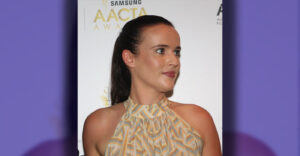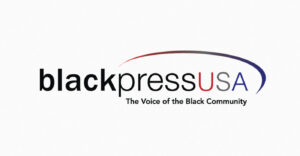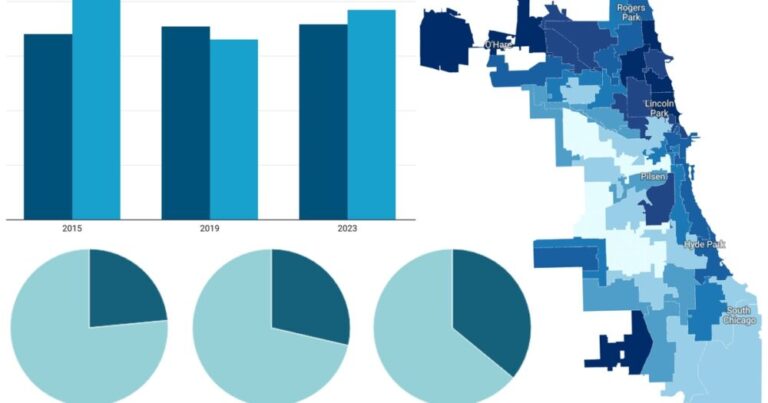Despite the threat of severe weather on Election Day, turnout was moderate in Chicago’s municipal runoff election, with more than a third of all registered voters casting ballots for mayor. This, however, was in large part due to early voting, which has continued to trend higher, with almost 57% of voters deciding to skip day-of voting at the polls and instead opting to vote by mail or at early voting sites.
Here’s an in-depth look at voter turnout data from the election, including turnout compared to past mayoral runoffs, what wards showed up at the highest rates and what age groups turned out the vote, according to unofficial results from the Chicago Board of Election Commissioners.
Citywide turnout was low to moderate, with 38.5% of registered voters in Chicago casting ballots in last week’s election.
Though voter turnout was moderate, it was still higher than usual. Turnout in April was about 5% higher than the average municipal election, at least as far back as Chicago Board of Election records show. In fact, citywide turnout was higher than it has been in all but two municipal elections since the turn of the century.
Hover over the columns to see what percent of eligible registered voters turned out for each election.
When zeroing in on mayoral runoff races, things look slightly different.
There have only been three mayoral runoffs in Chicago’s history — and all took place during the last three municipal election cycles.
Turnout in this year’s runoff was just slightly lower than in 2015′s contest between then-incumbent Mayor Rahm Emanuel and then-Cook County Commissioner Jesús “Chuy” García, but it was about 5% higher than 2019, when voters overwhelmingly chose Lori Lightfoot over Cook County Board President Toni Preckwinkle.
In 2015, there was a 7% increase in turnout from the general election to the runoff. Conversely, in 2019, there was about a 2.5% decrease in the number of voters who turned out for the runoff.
This year, turnout in the two election rounds were about the same, with slightly more voters casting ballots in the runoff, according to unofficial results.
Hover over the columns to see what percent of registered voters turned out for each election.
Voter turnout was generally higher on the North Side and in the lakefront wards — many of which cast ballots for alderman in addition to mayor.
Turnout, however, was highest in the 19th Ward, which encompasses the neighborhoods of Beverly, Morgan Park and Mount Greenwood, where more than 60% of those eligible voted. The ward with the lowest turnout, around 20%, was the 16th, covering parts of Englewood, Chicago Lawn and New City.
Hover over each ward to see the corresponding turnout rate.
Overall, voter turnout across the city’s 50 wards looked much the same as it did in February’s general election, with a few notable exceptions.
For example, the 32nd Ward, which includes parts of Bucktown, North Center, Lakeview and Lincoln Park, saw the greatest percent change in turnout, with a 19% increase from February.
Meanwhile, the 14th Ward, covering parts of Gage Park, Archer Heights, Garfield Ridge and Chicago Lawn, saw the greatest decrease in turnout, dropping almost 9%
Notably, the four of the five wards with the greatest decreases (the 14th, 12th, 15th and 22nd) turned out for returning mayoral candidate and now-U.S. Rep. Chuy García in the general election. So while García may have been able to mobilize voters in those wards in February, when he failed to make the runoff, some voters may have been less motivated to show up in April.
Hover over each ward to compare turnout rates in February’s general election with April’s runoff election.
Turnout was lowest among the youngest and oldest voters. Other than that, it was fairly evenly split across age groups.
Voters between the ages of 55 and 64 cast the most ballots in the runoff election, accounting for just over 18% of the total vote share. They were followed closely by those aged 65 to 74 and 35 to 44, with both groups sharing close to 17% of the vote.
Turnout was lowest in the youngest demographic of voters aged 18 to 24. That age group cast just over 20,000 ballots and accounted for about 4% of all votes.
Hover over each column to see the total number of ballots cast by each age group.
Though the 55 to 64 age group accounted for the most votes in the runoff, the 65-74 demographic voted at a rate higher than any other.
Those 65 to 74 made their voice heard last week, with 49% of registered voters in their age group casting ballots either by mail or at the polls.
Turnout was lowest among Generation Z, with only 19% of registered voters aged 18 to 24 participating in the municipal runoff election.
And unlike the February election, no age group saw more than 50% turnout.
There was a consistent trend in the percent change in voter turnout by age group from February. Across the board, more younger voters and less older voters turned out to vote in April.
The youngest voters aged 18 to 24 saw the greatest percent change in votes cast from February, with more than a 30% increase in turnout. Meanwhile, voters 75 and older saw the largest drop-off, with almost 8% less voters in their age group casting ballots in the April runoff.
A majority of Chicagoans decided to vote early — either by mail or in person — in the runoff election. Early voting smashed city records, with 56.6% of voters casting ballots prior to Election Day.
Still, out of the three ways to vote in Chicago, most people chose to cast their ballots the traditional way: in person on Election Day.
In-person voting on Election Day accounted for approximately 43% of all ballots, followed by in-person early voting at 30% and mail-in ballots at 26%.







